Ukraine profile - Timeline
- Published
A chronology of key events
9th century - Founding of Kievan Rus, the first major Eastern Slavonic state. The traditional account, a matter of debate among historians, attributes its founding to the semi-legendary Viking (or Varangian) leader Oleg, ruler of Novgorod, who went on to seize Kiev which, owing to its strategic location on the Dnieper River, became the capital of Kievan Rus.
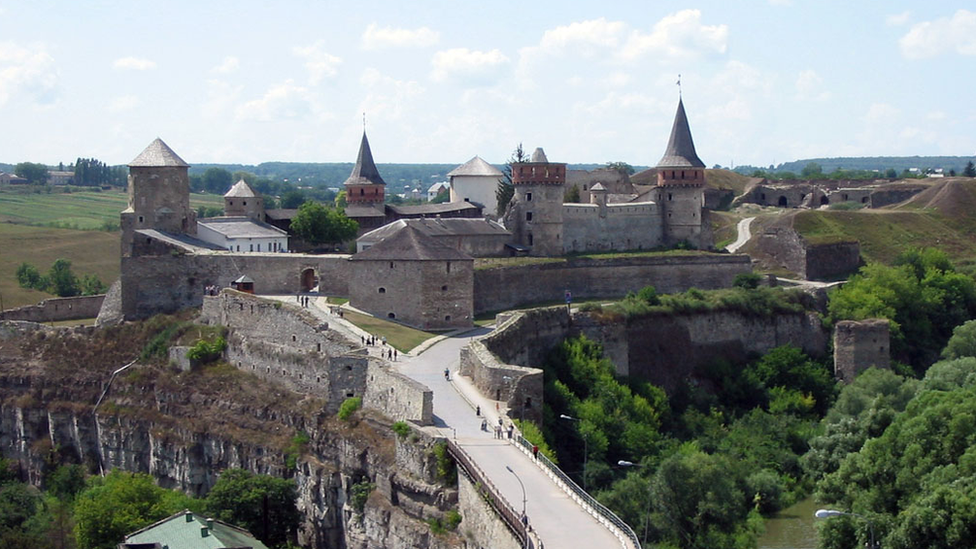
The town of Kamianets-Podilskyi was founded by Kievan Rus
10th century - Rurik dynasty established, and the rule of Prince Vladimir the Great (Prince Volodymyr in Ukrainian) heralds start of a golden age. In 988 he accepts Orthodox Christianity and begins conversion of Kievan Rus, thus setting the course for Christianity in the east.
11th century - Kievan Rus reaches its peak under Yaroslav the Wise (grand prince 1019-1054), with Kyiv becoming eastern Europe's chief political and cultural centre.
Foreign domination
1237-40 - Mongols invade the Rus principalities, destroying many cities and ending Kievan Rus's power. The Tatars, as the Mongol invaders became known, establish the empire of the Golden Horde.
1349-1430 - Poland and later the Polish-Lithuanian Commonwealth gradually annex most of what is now western and northern Ukraine.
1441 - Crimean Khanate breaks free of the Golden Horde and conquers most of modern southern Ukraine.
1596 - Poland establishes Greek-Catholic or Uniate Church, in union with Rome, which comes to predominate in western Ukraine. The rest of Ukraine remains overwhelmingly Orthodox.
1648-1657- Cossack uprising against Polish rule establishes Hetmanate, regarded in Ukraine as the forerunner of the modern independent state.
1654 - Treaty of Pereyaslavl begins process of transforming Hetmanate into a vassal of Russia.
1686 - Treaty of Eternal Peace between Russia and Poland ends 37 years of war with the Ottoman Empire in what is now Ukraine, and partitions the Hetmanate.
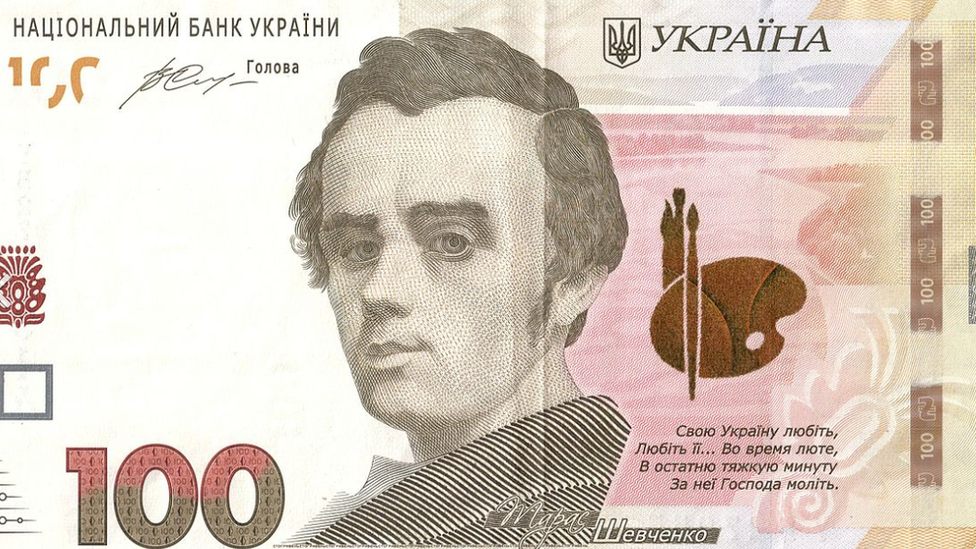
National poet Taras Shevchenko is commemorated on the 100-hryvnya banknote
1708-09 - Mazepa uprising attempts to free the eastern Hetmanate from Russian rule, during the prolonged Great Northern War that ranged Russia against Poland and Sweden at the time.
1764 - Russia abolishes the eastern Hetmanate and establishes the Little Russia governorate as a transitional entity until the full annexation of the territory in 1781.
Russian rule
1772-1795 - Most of western Ukraine is absorbed into the Russian Empire through the partitions of Poland.
1783 - Russia takes over southern Ukraine through the annexation of the Crimean Khanate.
19th century - National cultural reawakening sees the development of Ukrainian literature, education, and historical research. Habsburg-run Galicia, acquired during the partitions of Poland, becomes a centre for Ukrainian political and cultural activity, as Russia bans the use of the Ukrainian language on its own territory.
Rise of Soviet power
1917 - Central Rada council set up in Kyiv following collapse of Russian Empire.
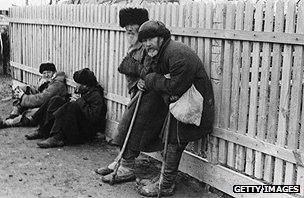
Millions of people, such as these farmers pictured near Kyiv in 1934, died in a man-made famine
1918 - Ukraine declares independence. Numerous rival governments vie for control for some or all of Ukraine during ensuing civil war.
1921 - Ukrainian Soviet Socialist Republic established when Russian Red Army conquers two-thirds of Ukraine. Western third becomes part of Poland.
1920s - The Soviet government encourages Ukrainian language and culture within strict political bounds, although this process is reversed in the 1930s.
1932 - Millions die in a man-made famine during Stalin's collectivisation campaign, known in Ukraine as the Holodomor.
1939 - Western Ukraine is annexed by the Soviet Union under the terms of the Nazi-Soviet Pact.
1941 - Ukraine suffers terrible wartime devastation as Nazis occupy the country until 1944.
More than five million Ukrainians die fighting Nazi Germany. Most of Ukraine's 1.5 million Jews are killed by the Nazis.
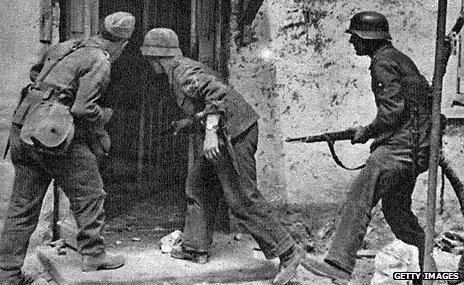
German troops storm a house in Sebastopol in 1942 during their occupation, in which millions lost their lives
1944 - Stalin deports 200,000 Crimean Tatars to Siberia and Central Asia following false accusations of collaboration with Nazi Germany.
1954 - In a surprise move, Soviet leader Nikita Khrushchev transfers the Crimean peninsula to Ukraine.
Armed resistance to Soviet rule ends with capture of last commander of Ukrainian Insurgent Army.
1960s - Increase in covert opposition to Soviet rule, leading to repression of dissidents in 1972.
1986 - A reactor at the Chernobyl nuclear power station explodes, sending a radioactive plume across Europe. Desperate efforts are made to contain the damaged reactor within a huge concrete cover.
Independence
1991 - Ukraine declares independence following attempted coup in Moscow.
1990s - About 250,000 Crimean Tatars and their descendants return to Crimea following collapse of Soviet Union.
1994 - Presidential elections: Leonid Kuchma succeeds Leonid Kravchuk, conducts policy of balancing overtures to the West and alliance with Russia.
1996 - New, democratic constitution adopted, and hryvnya currency introduced.
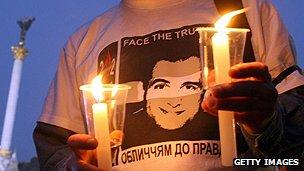
Journalist Georgiy Gongadze was murdered in 2000
2000 - Chernobyl nuclear power plant is shut down, 14 years after the accident. Well over ten thousand people died as a direct result of the explosion, the health of millions more was affected.
2002 March - General election results in hung parliament. Parties opposed to President Kuchma allege widespread electoral fraud.
2002 May - Government announces decision to launch formal bid to join Nato.
Orange Revolution
2004 November - Opposition leader Viktor Yushchenko launches mass protest campaign over rigged elections that gave victory to pro-Russian candidate Viktor Yanukovych. Supreme Court later annuls poll result.
2005 December - Viktor Yushchenko becomes president after winning December election re-run. Relations with Russia sour, leading to frequent disputes over gas supplies and pipeline transit fees.
2006 July - Socialist Party abandons Orange Revolution allies to form coalition with Viktor Yanukovych's Party of Regions and the Communists.
2008 October - Global financial crisis leads to decline in demand for steel, causing price of one of the country's main exports to collapse. Value of Ukrainian currency falls sharply and investors pull out.
Yanukovych comeback
2010 February - Viktor Yanukovych is declared winner of second round of presidential election.
2010 June - Parliament votes to abandon Nato membership aspirations.
2011 October - A court jails former Yulia Tymoshenko for abuse of power over a gas deal with Russia in 2009.
Maidan revolution
2013 November - Tens of thousands of protesters take to the streets to protest at the government's sudden decision to abandon plans to sign an association agreement with the EU, blaming Russian pressure.
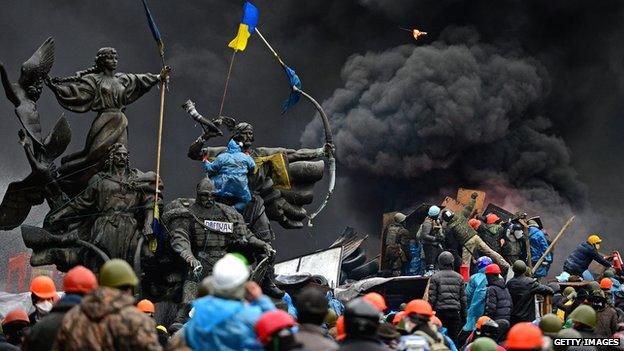
Months of at times violent protests culminated in the collapse of the Yanukovych government in 2014
2014 February - Security forces kill at least 77 protesters in Kyiv. President Yanukovych flees to Russia, opposition takes over.
2014 March - Russian forces annex Crimea, prompting biggest East-West showdown since Cold War. US and European Union impose ever-harsher sanctions on Russia.
2014 April - Pro-Russian armed groups seize parts of Donetsk and Luhansk regions on Russian border. Government launches military operation in response.
2014 May - Leading businessman Petro Poroshenko wins presidential election on pro-Western platform.
2014 July - Pro-Russian forces shoot down Malaysian airliner over eastern Ukraine conflict zone, killing all 298 people on board.
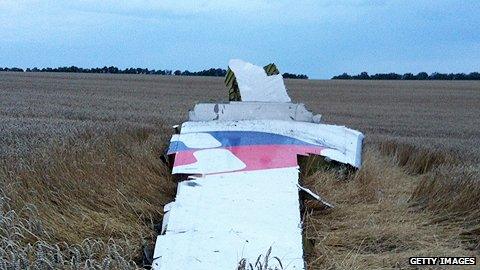
The wreck of the Malaysian airliner shot down over eastern Ukraine by pro-Russian armed group
2014 September - Nato confirms Russian troops and heavy military equipment entering eastern Ukraine.
2014 October - Parliamentary elections produce convincing majority for pro-Western parties.
European Union association
2015 February - Germany and France broker a new Donbass deal at talks in Belarus, resulting in a tenuous ceasefire.
2016 - Economy returns to fragile growth after two years of turmoil.
2017 July - Ukraine's association agreement with the European Union is ratified by all signatories, and comes into force on 1 September.
2018 May - Russian President Putin officially opens a bridge linking southern Russia to Crimea, an action Ukraine calls illegal.
2018 October - The Ecumenical Patriarch of Constantinople agrees to allow Ukraine to set up its own Orthodox Church independent of Russian ecclesiastical supervision.
President Zelensky takes office
2019 April-July - Television comedian Volodymyr Zelensky wins presidential election run-off in a landslide victory over incumbent Petro Poroshenko.
He takes office in May, and his Servant of the People party wins early parliamentary elections in July.
2019 August - Parliament appoints President Zelensky's aide Oleksiy Honcharuk prime minister.
2019 September - Russia and Ukraine swap prisoners captured in the wake of Moscow's seizure of Crimea and intervention in the Donbass.
2019 October - Ukraine becomes embroiled US impeachment row over allegations of President Trump attempting to put pressure on the country over investigating possible Democrat president rival Joe Biden.
2020 March - President Zelensky appoints former businessman Denys Shmyhal prime minister with a mandate to stimulate industrial revival and improve tax receipts.